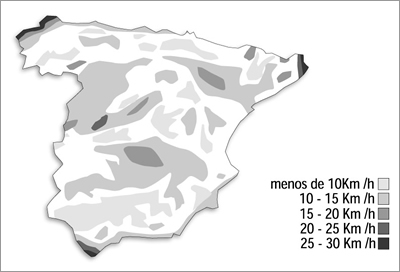Mediterranean storms
Easterly winds. The Easterly storm is a kind of Mediterranean gale from the Catalan and Balearic coasts. It usually occurs from December to May, unexpectedly and quickly. It passes from the Southwest wind with clear skies and pleasant temperatures to a cold Northeast with violent gusts of up to 198 Km / h (1960). A strong swell rises, which is very dangerous for small boats and has caused a lot of damage to the ports of these areas. Thus, for example, in February 1948 a storm of this type destroyed 50 m of breakwater at the port of Barcelona, making 4000 concrete blocks of 60 tons each disappear.
North Winds. The North winds are cold winds from the Northeast or North that blows on the coasts of the Balearic Islands and Catalonia. It can last several days with high winds and gusts of more than 100 km / h.
East Winds. It is a persistent wind that blows from the East. They are very frequent in the Alboran Sea and in the Strait. They can reach 120 km / h, causing very uncomfortable situations for navigation.
Atlantic Storms
Storms. The storms come from the Atlantic and especially affect Galicia and the Cantabrian cornice. In some cases they come from the final phase of tropical cyclones that begin in the equatorial zone, next to the coasts of Africa, go up to the Caribbean and the Atlantic coasts of North America and from there they turn towards the Peninsula. Normally by the time they reach the centre of the Atlantic on their way to Spain, they have already lost strength and stop calling themselves cyclones, but the rest that remains is still a heavy storm. Thus, for example, with the cyclones Hortensia and Klaus (1984), gusts of 150 km / h were blown.
Gales. They are sudden storms that affect the Cantabrian coast and the Bay of Biscay. They produce gusty winds of up to 180 km / h. When this storm occurs, it passes sharply from gentle winds from the south to hurricane winds from the North West, with a clear sky to stormy showers. The sea passes by storm surge or coarse sea in a very short time. They occur between May and October and cause shipwrecks (in 1912, for example, more than 100 fishermen in Bermeo died) and severe flooding in port cities.
Strong Winds. This is the name of the gusty winds that sometimes occur in the area of the Gulf of Cádiz and the lower Guadalquivir. They occur when strong storms approach the Portuguese coasts.
Local whirlwinds
Tornados. Although they are very rare in Spain, they have ever occurred, for example on December 27, 1978 at the Seville airport. In this meteorological phenomenon, the air turns (returning) around an axis with great force, in a narrow and high whirlwind. They are very destructive and there was one in the US, in 1925, which caused the death of 489 people and destruction of property along 352 kilometres. They are usually formed in groups and formations of up to 37 tornadoes in a day have been identified.
Marine downpours. This is called the prolongation in the form of a cloud tube of up to 200 m in diameter and about 1000 m high, which is located between the base of a cumulonimbus and the sea surface. They usually last half an hour, but their effects are devastating. They were very feared by the old sailboats that used to fire cannonballs, without much efficiency, with the intent of dispersing them. They are typical of warm waters and sometimes occur in the Mediterranean. The fishermen of the Balearic Islands call them “fiblo” or “catalyst”.





